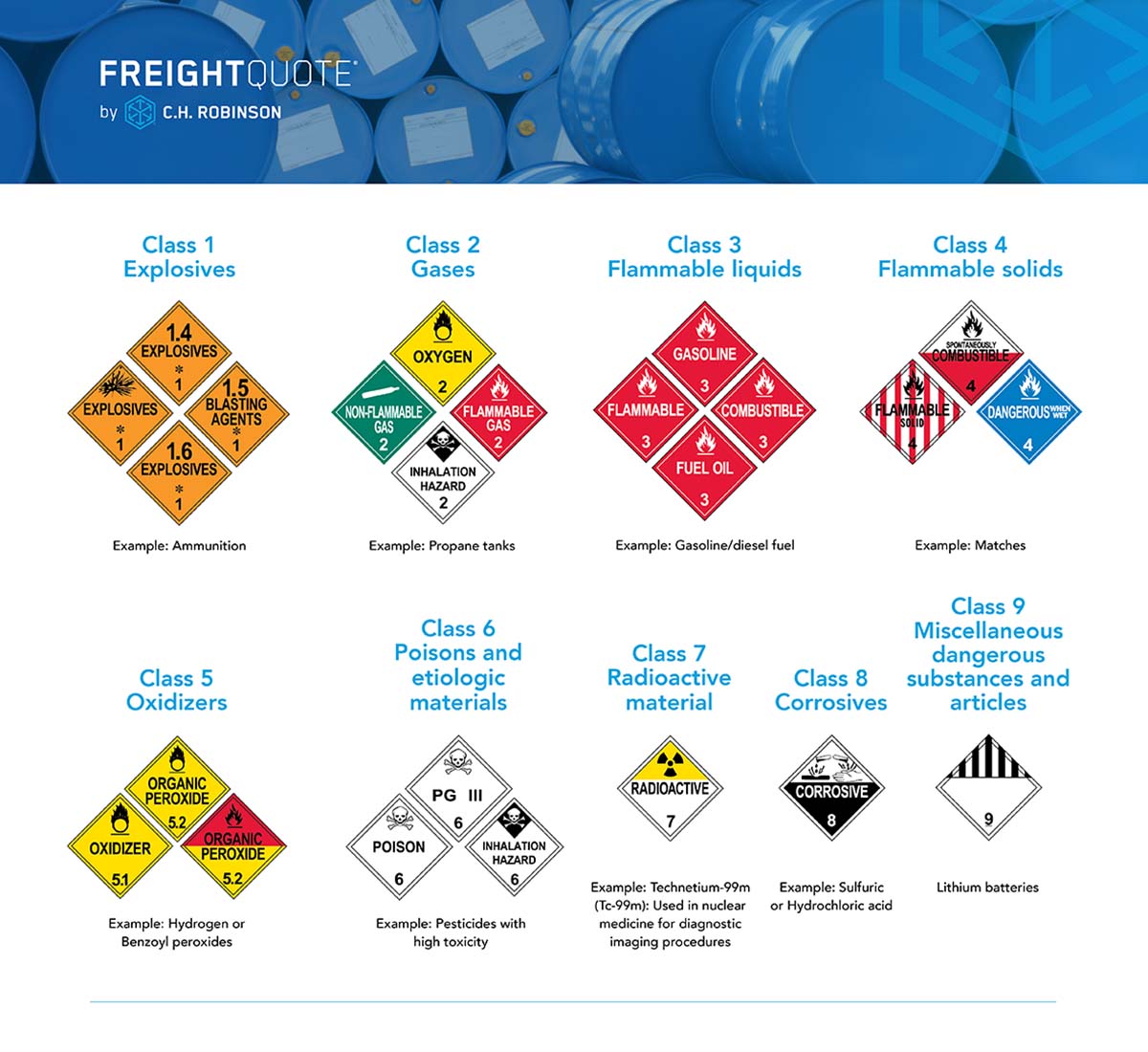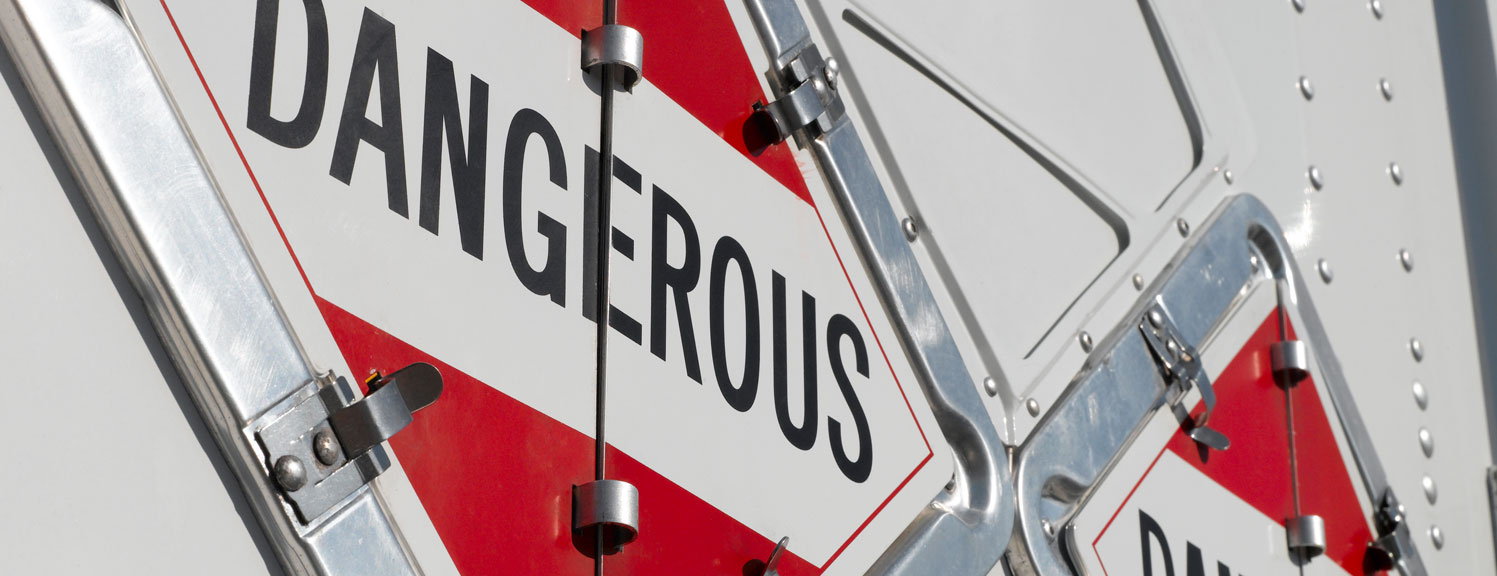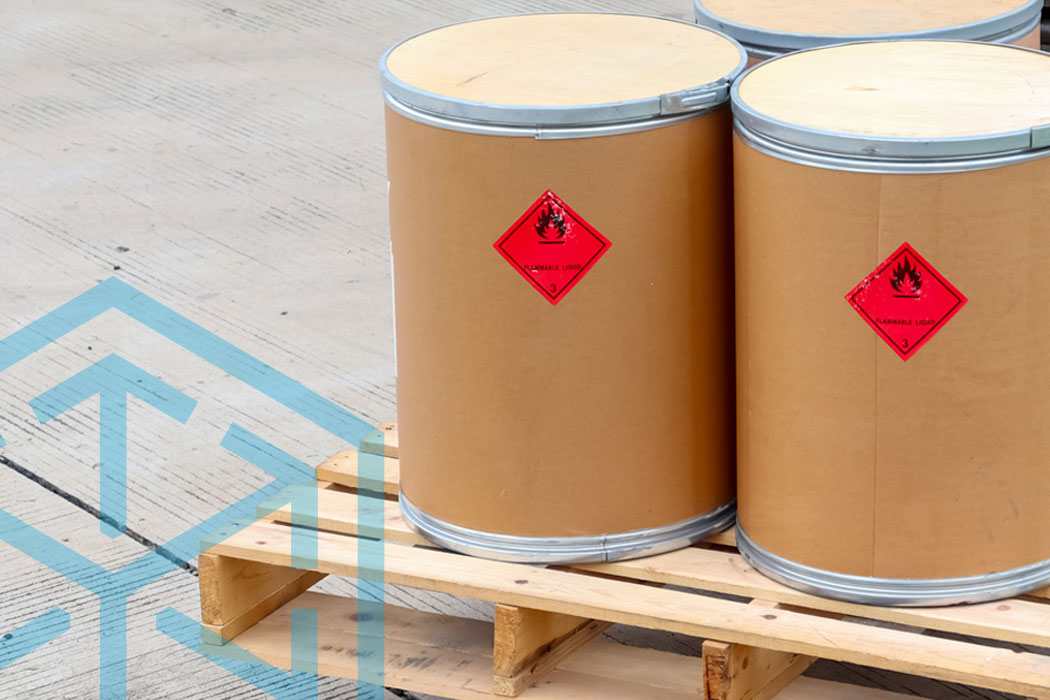Familiarize yourself with DOT hazardous material classifications
The U.S. Department of Transportation (DOT) has specific hazmat classes for shipping hazardous materials. Use this guide to understand the DOT hazard class for your shipment and find the best contract freight carriers that meet DOT safety and transportation requirements.
On this page:
Rely on Freightquote
Freightquote simplifies freight shipping. Get quotes and book your hazmat shipment with our freight experts.
How many hazard classes are there for fully regulated items?
Currently, there are nine hazard classes for fully regulated hazardous materials. Hazardous materials are defined by the U. S. Department of Transportation in accordance with the Federal Hazardous Material Law regulations. A DOT hazardous material classification is applied if a material, in a particular amount and form, poses an unreasonable risk to health, safety, or property.

DOT hazard class examples
Familiarize yourself with the regulations and guidelines regarding hazard class. When transporting hazmat goods, follow all necessary safety precautions to prevent accidents and ensure the safe delivery of these types of substances and articles.
The following list explains the nine DOT hazmat classes in more detail. For full information, visit the Department of Transportation.
| DOT Hazardous Classes | Category | Example |
| Class 1 | Explosives | Ammunition |
| Class 2 | Gases | Propane tanks |
| Class 3 | Flammable Liquids | Gasoline/ diesel fuel |
| Class 4 | Flammable Solids | Matches |
| Class 5 | Oxidizers | Hydrogen or benzoyl peroxides |
| Class 6 | Poisons and etiologic materials | Pesticides with high toxicity |
| Class 7 | Radioactive material | Technetium-99m (Tc-99m): Used in nuclear medicine for diagnostic imaging procedures |
| Class 8 | Corrosives | Sulfuric or hydrochloric acid |
| Class 9 | Miscellaneous dangerous substances and articles | Lithium batteries |
DOT hazard class 1: Explosives
Class 1 hazardous materials require extreme care during transport due to their potential for causing significant harm or damage. Class 1 explosives are further divided into six divisions based on their characteristics:
Division 1.1: Explosives with a mass explosion hazard
Division 1.2: Explosives with a projection hazard
Division 1.3: Explosives that predominantly pose a fire hazard
Division 1.4: Explosives with no significant blast hazard
Division 1.5: Very insensitive explosives
Division 1.6: Extremely insensitive explosive articles
Anyone involved in the shipping or handling of these materials must be properly trained and follow all safety regulations and guidelines to ensure public safety and compliance with the law.
DOT hazard class 2: Gases
These gases have the potential to pose health and safety hazards during transportation. Class 2 gases are further divided into three divisions based on their characteristics:
Division 2.1: Flammable gases
Division 2.2: Non-flammable gases
Division 2.3: Poison gases
All Class 2 gases must be packaged in a way that prevents them from leaking or releasing their hazardous properties during transportation. The packaging must also be strong enough to withstand the rigors of transportation.
DOT hazard class 3: Flammable liquids
Flammable liquids can pose fire and explosion hazards during transportation and handling due to their flashpoint. The flashpoint is the minimum temperature when a liquid gives off enough vapor to ignite in the presence of an open flame or spark.
Division 3.1: Flashpoint below -18°C (0°F)
Division 3.2: Flashpoint between -18°C and 23°C (73°F)
Division 3.3: Flashpoint between 23°C and 61°C (141°F)
When shipping or handling flammable liquids, follow all specific regulations and safety guidelines to prevent accidents and ensure public safety.
DOT hazard class 4: Flammable solids
Class 4 flammable solids can easily ignite and burn when exposed to heat, friction, or other sources of ignition. Flammable solids are classified into three divisions based on their ignition characteristics and burning behavior during transportation:
Division 4.1: Flammable solids
Division 4.2: Spontaneously combustible materials
Division 4.3: Materials that are dangerous when wet
When shipping or handling flammable solids, follow strict adherence to safety regulations to minimize risk and ensure the safety of individuals and the environment.
DOT hazard class 5: Oxidizers and organic peroxides
DOT Hazard Class 5 goods are materials that, while not combustible themselves, can cause or contribute to the combustion of other substances by providing oxygen or supporting the release of oxygen. Hazard class 5 is further divided into two divisions:
Division 5.1: Oxidizers
Division 5.2: Organic peroxides
Protect individuals, property, and the environment from potential hazards by following proper safety measures and adhering to regulations.
DOT hazard class 6: Poisons and etiologic materials
DOT Hazard Class 6 poisons can cause illness or death if they are swallowed, inhaled, or absorbed through the skin. These materials are divided into two divisions:
Division 6.1: Poisonous materials
Division 6.2: Etiologic (infectious) materials
If you are shipping hazard class 6 materials, familiarize yourself with the applicable regulations and take all necessary steps to help ensure the safe transportation of these dangerous materials.
DOT hazard class 7: Radioactive material
These substances emit ionizing radiation, such as alpha, beta, gamma, or neutron radiation. Radioactive materials are used in various fields, including medical, industrial, and scientific applications, but they also pose potential hazards to human health and the environment if not handled and transported safely. Hazard class 7 is further divided into two categories:
Division 7.1: Contains radioactive isotopes and emit ionizing radiationDivision 7.2: Contains lower levels of radioactivity compared to division 7.1 materials, intended for materials that have limited radioactivity and present a lower potential risk.
Be aware that radioactive materials are labeled with the radiation symbol (the trefoil) and must have appropriate warning labels and markings on their packaging.
DOT hazard class 8: Corrosives
Corrosive substances are materials that can cause severe damage or destruction to living tissue or materials they come into contact with through chemical reaction.
While hazard class 8 is not divided into divisions, they are identified and classified based on their corrosive properties, and they can be liquids, solids, or gases.
Proper storage and handling are crucial to ensure the safe transportation of corrosive materials.
DOT hazard class 9: Miscellaneous dangerous substances and articles
A material that presents a hazard during transport, but which is not included in another hazardous freight classification falls under DOT hazard class 9.
Because class 9 includes a diverse range of hazardous materials and articles, the specific packaging, labeling, and handling requirements can vary depending on the nature of the substance or article.

Shipping hazardous materials
Packaging hazardous freight
Packaging hazardous freight requires careful consideration and compliance with specific regulations to ensure the safe transportation of these materials. The packaging must be designed to protect the freight from damage during transit, prevent leaks or spills, and reduce the risk of hazards to people and the environment.
Freightquote offers packaging tips for small businesses, but be sure to refer to the U.S. Department of Transportation (DOT) Hazardous Materials Regulations (HMR) website for specific packaging requirements based on the hazard class of the material being transported.
Marking and labeling dangerous goods
Hazardous materials must be properly marked and labeled to indicate the hazards they present. Specifically, the inclusion of labels with hazard symbols and warnings on packages and transport vehicles are required.
Markings and labels also provide clear identification of the nature of the hazardous material being transported. They indicate the hazard class, division, and any specific characteristics or risks associated with the material. This information helps transport personnel, emergency responders, and others involved in handling the goods to recognize and respond appropriately to potential hazards.
What to include when shipping hazardous materials
If you are shipping hazardous materials, make sure you have all required information included in your bill of lading (BOL). This information will help ensure the hazardous materials are handled safely during transportation. Be sure to include:
- Description of the hazardous material: This includes the identification number, the proper shipping name, the hazard class, and the packing group (when applicable).
- Quantity of the hazardous material: The quantity of the hazardous material must be stated in both numerical and weight terms.
- Name and address of the shipper: The shipper's name and address must be included on the shipping paper.
- Name and address of the consignee: The consignee's name and address must also be included on the shipping paper.
- Emergency contact information: The shipping paper must include the emergency contact information for the shipper and the consignee, including telephone numbers.
When working with Freightquote, this is all required information for hazardous materials and is automatically generated on your BOL during the booking process.


